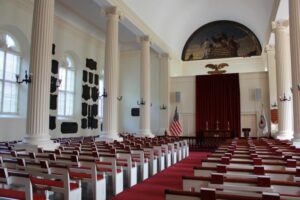Regardless of their political party or philosophical persuasion, all Americans agree that the job of President of the United States is a killer. The decisions are constant and the stress is unrelenting. And, as President Ronald Regan observed, when you live upstairs from “the store,” there’s no such thing as sneaking out early. All of that is especially true in times of war, and, in 1943, the War was worldwide. The President at the time was Franklin Delano Roosevelt, and, physically, he should have been the one least capable of handling it. A wealthy New York patrician, he had been stricken with polio myelitis when he was 39 years old; it left him partially paralyzed and unable to walk. As we wrote in The Log of October 31, 2019, “he could have stayed home covered with a shawl, sitting in a rocking chair on the porch of the family’s home
Read More
A forgotten, unsung hero.
A first-time visitor to the Washington Monument in our nation’s Capital may get something of a shock. There’s no doubt that the world’s tallest obelisk, standing at over 555 feet and gleaming in the sunlight is a fitting tribute to America’s first President. But anyone who is not blinded by sheer patriotism can easily see there is a major flaw:about one-third of the way up the monument, the color of the stone changes from a light cream/tan to a crisp white. And try as you might to chalk up the error to a gigantic shadow, or the vagaries of outdoor illumination, the break between the bottom third and the top two thirds of the obelisk appears to be a straight line. It doesn’t just “appear” to be a straight line; it is a straight line. There’s a reason for that, and it commemorates a deed that involves a hero
Read More
Niagara Falls – It’s Just a Matter of Time
Niagara Falls! Whether you know it as the Honeymoon Capital or a punch line to a running gag from an Abbott and Costello skit, you can be sure of one thing: the Falls at Niagara isn’t a place–it’s a work in progress. First consider the facts: the Niagara River is approximately 36 miles long, and it flows northward from Lake Erie to Lake Ontario, which is the lowest of the five Great Lakes and is the only one that is connected to the Atlantic Ocean. The Niagara is the only natural outlet for the upper lakes. Every drop of water, every molecule, in Lake Superior and its sisters must make its way “down” to Lake Erie, and then north, to Lake Ontario. The upper lakes are around 550 feet above sea level, and the water has to drop around 300 feet to get to Lake Ontario and from there work
Read More
Who Says We Can’t?
In Harbor of Refuge, the Commodore’s wife, Judy Hennel, explains to newcomer Marilyn Dupré that, in spite of Bonita Key Yacht Club’s stand-offish reputation, the members were “really a family.” And, when Marilyn questions that statement, thinking about the fact that one of her employers had waited over a year to simply get a membership application, Judy replies “Well, you wouldn’t let just anyone into your family, would you?” As we enter the 4th month of a nationwide “lockdown” intended to at least slow the progress of a deadly new virus, Judy Hennel’s words should strike home to many Americans who have never heard her name or read the romantic novel that lovingly teaches many of life’s greatest lessons. It seems that, as “Grandma Calkins” told Marilyn, “we cannot live without love,” and, for many of us who are deprived of family love by distance or age or, perhaps–in very
Read More
Quarantine!
Quarantine: What it Meant and How it Began The year was 1348, and the bubonic plague was spreading its black pall of death over Europe. Venice, one of Italy’s most important ports, lost 600 citizens in a single day. The Venetian Council frantically sought a means to protect their city, and ordered the Doge (their senior-most elected official) to command all incoming ships to remain at anchor, and traders to remain outside the walls, for quaranta giorni, or “forty days.” The number of days was no accident; according to the Bible, Christ himself had spent forty days in the wilderness cleansing himself and preparing for his ministry. Forty days was a divine number. Quaranta Girorni became, of course, the word “Quarantine”; a concept which quickly was adopted throughout the world and is with us to this day. A vessel entering a foreign port is required to anchor, raise a yellow
Read More
All Hail the Entrance of the Boar’s Head!
The tradition of the Boar’s Head Festival goes back to Medieval England, where, it is said, on a cold Christmas Eve in the 14th century (or, perhaps, the 16th century—nobody is entirely sure), a university student was walking through the woods, lost in thought as he studied his copy of Aristotle. In the fading twilight a wild boar attacked the scholar, and the quick-thinking lad saved himself by ramming his book down the animal’s throat. The next day’s feast at Oxford featured a tasty treat: roast pork. It was the custom of the time to present the head of the animal to the hunter, but, in honor of the day, the Boar’s Head was brought into the dining hall and set before an effigy of the Christ Child, in thanksgiving for the young man’s life. Over the years, the Boar’s Head ceremony was seen to represent God’s power to slay evil, and the
Read More
“Never, never, never give up.” — Winston Churchill
This 1905 photograph hangs in the Hudson River Ice Yacht Club. It shows one of the most remarkable men of the 20thcentury at the helm. It would be meaningless if he had not identified himself by the inscription on the back which reads, in part, “I enclose two copies of prints enlarged from a Kodak, showing me at the helm of the ice yacht HAWK. I suggest that you have this framed and hung on the wall over the spars. . . .” We’ll get to the “driver” in a minute, but first, for those of us who live in warmer climes, and believe that “ice” is something that is found only in refreshing drinks, a few words about the peculiar world of iceboating: What is an Iceboat? An iceboat consists of a long, slim hull attached to a perpendicular cross- piece called a “runner plank.” The boat is supported by
Read More
“Salvage” does not mean “Finders Keepers”
Last month I left a lot of readers hanging when I mentioned that the intricacies of the Law of Salvage were brought home to me during my tenure as an Assistant Attorney General. A local denizen of the community (no doubt one of the “flotsam and jetsam of humanity” from last month) had been convicted of stealing a boat and sent off to prison from which he launched an appeal. He represented himself and wrote a brief in which he argued the State of Florida could not prosecute him because by taking the boat he was acting under the “federal law of salvage.” Since his brief contained the word “boat,” and everybody knew I was a “past commodore,” the case was assigned to me. I quickly headed to our law library to do some research. I learned that “salvage” does not mean “finder’s keepers.” In fact, the Law of Salvage is pretty
Read More
What is a club?
What is a “club,” anyway? As far back as the first paperback edition of Yachting Customs and Courtesies (20 years ago!) we’ve repeated the same mantra: “A club is first and foremost a group of people. Compatibility comes first; the name is secondary.” The lesson could not have been plainer than it was earlier this month when the Palm Beach Sailing Club provided the venue for the Jack Swenson Memorial race which was hosted by the Royal Turkey Yacht Club. The regatta was part of the international laser masters series and attracted 68 competitors from 8 countries. A few people (fewer every year, thank goodness) become red in the face and argue that a “sailing” club cannot, by its very nature, be a “yacht” club, ignoring some very fine old institutions like the Buffalo Canoe Club whose clubhouse is not located in Buffalo, and whose only canoes are two on
Read More
Preserving your good name to the very end
The first Cadet Chapel was constructed on the grounds of the United States Military Academy at West Point, NY, in 1836. Its unadorned windows, severe Gothic design and plain white walls accentuate both its ecumenical use and its military heritage. Fittingly, the only decoration other than the “Peace and War” mural by Robert W. Weir, an Academy professor from 1833 to 1876, consists of black marble tablets, mounted around the walls; each tablet bearing in gold the name, rank, and dates of birth and death of a general officer of the Revolutionary War. High up in a rear corner of one wall, almost out of sight near the railing of the choir loft–and, in fact, cut off by the railing–is a solitary plaque which carries only the rank and date of birth of a general officer of that war. The name and date of death have been conspicuously removed. It
Read More


